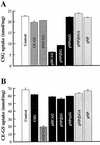Alternate energy-dependent pathways for the vacuolar uptake of glucose and glutathione conjugates
- PMID: 12428021
- PMCID: PMC166675
- DOI: 10.1104/pp.008334
Alternate energy-dependent pathways for the vacuolar uptake of glucose and glutathione conjugates
Abstract
Through the development and application of a liquid chromatography-mass spectrometry-based procedure for measuring the transport of complex organic molecules by vacuolar membrane vesicles in vitro, it is shown that the mechanism of uptake of sulfonylurea herbicides is determined by the ligand, glucose, or glutathione, to which the herbicide is conjugated. ATP-dependent accumulation of glucosylated chlorsulfuron by vacuolar membrane vesicles purified from red beet (Beta vulgaris) storage root approximates Michaelis-Menten kinetics and is strongly inhibited by agents that collapse or prevent the formation of a transmembrane H(+) gradient, but is completely insensitive to the phosphoryl transition state analog, vanadate. In contrast, ATP-dependent accumulation of the glutathione conjugate of a chlorsulfuron analog, chlorimuron-ethyl, is incompletely inhibited by agents that dissipate the transmembrane H(+) gradient but completely abolished by vanadate. In both cases, however, conjugation is essential for net uptake because neither of the unconjugated parent compounds are accumulated under energized or nonenergized conditions. That the attachment of glucose to two naturally occurring phenylpropanoids, p-hydroxycinnamic acid and p-hydroxybenzoic acid via aromatic hydroxyl groups, targets these compounds to the functional equivalent of the transporter responsible for chlorsulfuron-glucoside transport, confirms the general applicability of the H(+) gradient dependence of glucoside uptake. It is concluded that H(+) gradient-dependent, vanadate-insensitive glucoside uptake is mediated by an H(+) antiporter, whereas vanadate-sensitive glutathione conjugate uptake is mediated by an ATP-binding cassette transporter. In so doing, it is established that liquid chromatography-mass spectrometry affords a versatile high-sensitivity, high-fidelity technique for studies of the transport of complex organic molecules whose synthesis as radiolabeled derivatives is laborious and/or prohibitively expensive.
Figures







References
-
- Brown MH, Neighbors SM. Soybean metabolism of chlorimuron ethyl: physiological basis for soybean selectivity. Pestic Biochem Physiol. 1987;29:112–120.
-
- Coleman JOD, Randall R, Blake-Kalff MMA. Detoxification of xenobiotics in plant cells by glutathione conjugation and vacuolar compartmentalization: a fluorescent assay using monochlorobimane. Plant Cell Environ. 1997;20:449–460.
-
- Dickson R, Larsen B, Viitanen PV, Tormey MB, Geske J, Strange R, Bemis LT. Cloning, expression, and purification of a functional nonacetylated mammalian mitochondrial chaperonin 10. J Biol Chem. 1994;269:26858–26864. - PubMed
-
- Ford CM, Boss PK, Hoj PD. Cloning and characterization of Vitis vinifera UDP-glucose:flavonoid 3-O-glucosyltransferase, a homologue of the enzyme encoded by the maize bronze-1 locus that may primarily serve to glucosylate anthocyanidins in vivo. J Biol Chem. 1998;273:9224–9233. - PubMed
-
- Fraissinet-Tachet L, Baltz R, Chong J, Kauffmann S, Fritig B, Saindrenan P. Two tobacco genes induced by infection, elicitor and salicylic acid encode glucosyltransferases acting on phenylpropanoids and benzoic acid derivatives, including salicylic acid. FEBS Lett. 1998;43:319–323. - PubMed
Publication types
MeSH terms
Substances
LinkOut - more resources
Full Text Sources
Other Literature Sources

